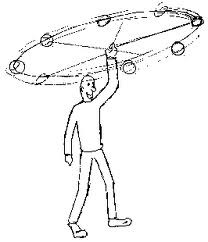When a beginner learns a new technique they naturally rely on their five physical senses and try to understand the skill at an intellectual level. They commit to memory what they can see and take pride in being able to explain the steps clearly to a less experienced student. This can be incredibly helpful – but if understanding of the skill remains at this stage the student may lack the ability to translate the technique to a different sized or shaped opponent. When this happens many students resort to using physical strength, something which not only puts the weaker student at a disadvantage but also makes injury more likely.
Moving from novice to advanced is not about being able to explain the movement in words – though granted it can help in the teaching process. Really learning a skill comes from learning to feel it – aligning oneself with the natural flow between two individuals – and learning to feel a connection with the opponent.
 For new students I often use the analogy of a heavy object on the end of a rope. Somehow, when we grab one end of the rope we need to be able to sense the ball at the other end; we need to feel it and then learn to direct it. When we lose connection with the ball we lose our ability to control it’s movement – just like we can lose the ability to throw an opponent when we no longer sense their body through the physical connection we have with them.
For new students I often use the analogy of a heavy object on the end of a rope. Somehow, when we grab one end of the rope we need to be able to sense the ball at the other end; we need to feel it and then learn to direct it. When we lose connection with the ball we lose our ability to control it’s movement – just like we can lose the ability to throw an opponent when we no longer sense their body through the physical connection we have with them.
Being able to ‘feel’ your opponent when doing a skill requires your full presence and intention in the moment. It’s about being in a particular state of mind that enables us to respond appropriately to how our opponent is presenting themselves and then to project our energy.
The essence of Hapkido training is about learning this state of mind. Our repetitive practice demands clarity of mind, focus, proper timing, discipline, mental agility, and ultimately an ability to let go of the multitude of distractions and feel a connection to our surroundings and to our action.
